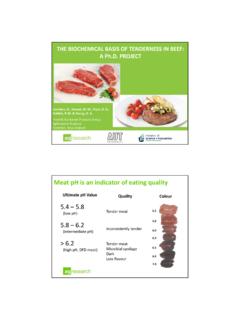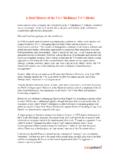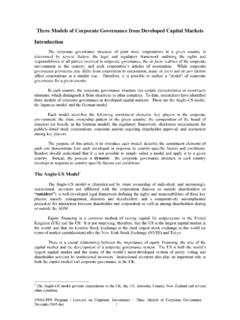Transcription of Review of the Literature on Enterprise Risk Management
1 Business Management dynamics , , Nov 2011 , Society for Business and Management dynamics Review of the Literature on Enterprise Risk Management Ahmad Rizal Razali1 and Izah Mohd Tahir2 Abstract The aim of this paper is to Review previous studies on Enterprise Risk Management (ERM). Previous studies show that empirical works on ERM are still limited. Research using both primary and secondary data will be discussed. From the previous studies, it was found that most of the studies in Malaysia on risk Management or ERM used primary data. The scopes of the previous studies in Malaysia include construction, financial institutions, service sector, technology, industrial products, consumer products, plantation and trade and services, and these studies used mail questionnaires and interviews. While studies from the secondary data focus on industrial product companies, of which data are gathered from their annual reports.
2 Key words: Literature Review , Enterprise Risk Management , Primary Data, Secondary Data Available online ISSN: 2047-7031 INTRODUCTION The word Enterprise for Enterprise Risk Management (ERM) itself shows a different meaning than Traditional Risk Management (TRM). Enterprise means to integrate or aggregate all types of risks ; using integrated tools and techniques to mitigate the risks and to communicate across business lines or level compared to Traditional Risk Management . Integration refers to both combination of modifying the firm s operations, adjusting its capital structure and employing targeted financial instruments (Meulbroek, 2002). It was argued that the term ERM has quite similar meaning with Enterprise -Wide Risk Management (EWRM), Holistic Risk Management (HRM), Corporate Risk Management (CRM), Business Risk Management (BRM), Integrated Risk Management (IRM) and Strategic Risk Management (SRM) (D Arcy, 2001; Liebenberg and Hoyt, 2003; Kleffner et al.)
3 , 2003; Hoyt and Liebenberg, 2006; Manab et al., 2007; and Yazid et al., 2009). There are various definitions of ERM. For example, in the middle of 2004, the Committee of Sponsoring Organization of the Treadway Commission (COSO) released the Enterprise Risk Management Integrated Framework. COSO defines Enterprise Risk Management as a process, affected by an entity s board of directors, Management and other personnel, applied in strategy-setting and across the Enterprise , designed to identify potential events that may affect the entity, and manage risk to be within its risk appetite, to provide reasonable assurance regarding the achievement of entity objectives. CAS or Casualty Actuarial Society (2003) defines Enterprise Risk Management as disciplines by which an organization in any industry assesses, controls, exploits, finances, and monitors risks from all sources for the purposes of increasing the organization s short- and long-term value to its stakeholders.
4 Lam (2000) on the other hand, defines Enterprise Risk Management as an integrated framework for managing credit risk, market risk, operational risk, economic capital, and risk transfer in order to maximize firm value. Makomaski (2008) defines Enterprise Risk Management as a decision-making discipline that addresses variation in company goals. Alviunessen and Jankensg rd (2009) point out that Enterprise Risk Management is concerned about a holistic, company-wide approach in managing risks , and centralized the information according to the risk exposures. They use the term Risk Universe , which is the risk that might impact on the future cash flow, profitability and continued existence of a company. In other words, risk universe is risk that could affect the entity of the company. If risk universe can be identified, the next step is to take an appropriate action such as risk mapping process, accessing the likelihood and impact and curb the risk based on the organizations objective.
5 1 Faculty of Business Management and Accountancy, University Sultan Zainal Abidin, Malaysia, 2 Faculty of Business Management and Accountancy, University Sultan Zainal Abidin, Malaysia, Business Management dynamics , , Nov 2011 , Society for Business and Management dynamics Therefore, Enterprise Risk Management can be defined as a systematically integrated and discipline approach in managing risks within organizations to ensure firms achieves their objective which is to maximize and create value for their stakeholders. There are two key points that must be highlighted according to the definitions given above. The first key point is the main role of ERM itself - it integrates and coordinates all types of risks across the entire organization. It means that risks cannot be managed in silo approach.
6 All risks occurred in the entity must be combined and managed in Enterprise approach. The second key point is by using ERM, users are able to identify any potential incidents that may affect the organization and know their risk-appetite. If the risk-appetite is specifically known, any decision made by the organization to curb risks may be parallel with the firm s objective (Walker et al., 2003). DEVELOPMENT ON Enterprise RISK Management This section will discuss briefly the development of ERM especially on the emerging factors that influence companies to shift from risk Management practices (Traditional Risk Management ) to Enterprise Risk Management . The discussions will focus from the theoretical perspectives; academic and professional bodies. D Arcy (2001) has postulated that the origin of risk Management was developed by group of innovative insurance professors Robert I.
7 Mehr and Bob Hedges in 1950s. In the 1963s, the first risk Management text entitled Risk Management and the Business Enterprise was published. The objective of risk Management at that time was to maximize the productive efficiency of the Enterprise . At that time, risk Management was specifically focused on pure risks and speculative risks . In the 1970s, when Organization of Petroleum Exporting Countries (OPEC) decided to reduce production in order to increase the price, financial risk Management became an interesting issue highlighted by firms because the increment in oil price has affected the instability in exchange rates and inflation rate (D Arcy, 2001; Skipper and Kwon, 2007). Later in 1980s, political risks attracted more attention from multinational corporations as a result of different political regimes in different countries.
8 For example, when the government announced a new policy, investors and corporations must make decision to reduce risk (Skipper and Kwon, 2007). According to D Arcy (2001), during this era, organizations did not properly apply risk Management because they did not apply the risk Management tools and technique such as options. Therefore, it had increased the cost of operations of the organizations. During this era, the silo mentality still remains (Skipper and Kwon, 2007). In the 1990s, the use of financial tools such as forwards and futures are widely practiced in the United States. In addition, pressure from shareholders and stakeholders to take more action rather than buying insurance to fight against uncertain loss or financial crisis, influenced managers to mitigate risks more proactively.
9 It demanded managers to retrieve better risk information and risk Management techniques. During this time, risk Management was closely related to financial, operational and strategic risks , not only hazard risks (Skipper and Kwon, 2007). Hazard risk refers to any source that may cause harm or adverse effects such as equipment lose due to natural disasters for example, the Hurricane Katrina that happened in United States in 2005. There are various risks that can occur. These include financial risk, strategic risk and operational risk. Financial risk refers to any loss due to economic conditions such as foreign exchange rates, derivatives, liquidity risks and credit risks . Apart from the corporate scandals in Enron, WorldCom, Polly Peck and Parmalat, the last decade showed how serious the financial scandal was to corporations and banks (Jones, 2006; Benston et al.)
10 , 2003). Another example was in 1994, the Orange County s Investment Pool lost billion from structured notes and leveraged repo positions, while in 1995, Barings Bank and Daiwa Bank lost billion and billion respectively due to losses in futures and options trading and unauthorized derivatives trading. The same financial disaster occurred in 1996 when Sumitomo Corp. lost billion as a result of the actions of its head copper trader, Yasuo Hamanaka who secreted his activities in unauthorized copper trading on the London Metal Exchange (Holton, 1996; D Arcy, 2001). Business Management dynamics , , Nov 2011 , Society for Business and Management dynamics Li and Liu (2002) define strategic risk as the uncertainty of loss of a whole organization and the loss may be profit or non-profit, while Mango (2007) points out that there is no specific definition of strategic risk due to the inability to well-define and understand it.



